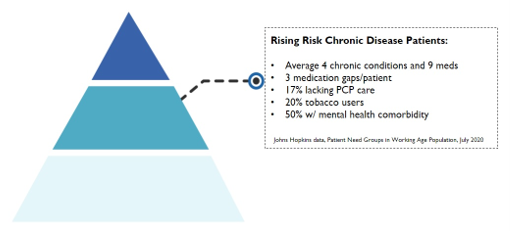

When determining the level of care patients receive, health systems and providers have many factors to consider.
The ACG System helps users determine the amount of risk each patient carries, from low- to high-risk. However, an elusive group is often those that are “rising risk”, those who are medium- or low-risk now but on-track to become high risk. Identifying this population and intervening appropriately is crucial to creating better health outcomes for patients and lowering costs for providers.
Today’s blog post talks about how the ACG System can identify this “rising-risk” group and how providers, health systems and patients alike can benefit from this information.
When we think about the levels of patient need as a pyramid, low-risk patients are in the bottom tier, often representing the largest group of patients but the lowest cost. These patients are generally healthy and often refill their prescriptions on time, receive regular preventive health care and have a minimal number of, or well-managed, conditions. The patients at the very top of the triangle have the highest amount of need. They have the highest health care costs, multiple chronic conditions and may be frail or elderly. This group of patients requires a lot of attention, however, they are unlikely to move back into one of the lower-need categories, even with higher levels of care.

When we identify “rising-risk,” it often refers to the patients in the middle of the pyramid. These patients are moderately complex. They may have a few chronic conditions, issues with medication adherence, above-average utilization and possibly a mental health condition. The goal is to either bring these patients back into the lower-need category or prevent them from moving to the highest level of need. By identifying this population, providers and health systems can intervene in an impactful way to preserve their patients’ health and lower health care costs.
Within the ACG System, there are a number of ways patients can be segmented and stratified into various groups, allowing System users to group and view their patients. In order to understand the volume of patients in each tier, users can visualize the patient population in a pyramid and segment them into categories based on cost, utilization, condition count and level of health.
Once the patient population has been stratified into low, medium and high groups, layering on “risk” is a key component. The ACG System has multiple predictive and concurrent models to both assign and predict risk of patient populations. These models can identify those at various levels of risk of being high cost, having an inpatient admission or readmission, or unexpected pharmacy cost, among others, and further stratify patients into segments on a spectrum of predicted future need.
Further, the ACG System’s proprietary Emergency Department Classification segmentation methodology can classify patients who have had multiple ED visits that are labeled as non-emergent or emergent, and potentially avoidable or primary care treatable. This, too, is another way to identify those in various segments whose utilization has been suboptimal in the past. The ACG System can also identify those with Social Determinants of Health needs based on their geographic location, those with identified and coded social factors and those with impactable health needs, all of which can be identified so that providers can offer appropriate interventions to provide better care and lower costs.
Many sectors in the health care space can benefit from identification of rising risk patients. Health plans, especially those in the Medicare and Medicaid spaces, have a vested interest in identifying their rising-risk members in order to lower overall costs. If rising-risk patients are identified and targeted with appropriate interventions, the likelihood of their condition improving increases, and as a result, prevents the patient from moving up the risk pyramid, incurring more costs and experiencing worsened health.
For example, a health plan may involve a care manager to implement smoking cessation programs to rising-risk tobacco users, or implement weight-loss interventions to members who are overweight. Care managers can also reach out to patients upon discharge to ensure they are adequately cared for at home. Health plans could also develop a partnership with a transportation company in order to help diabetics with medication adherence and transportation issues get to their health care providers and their pharmacy.
Health systems and providers can also use the ACG System to understand the risk-level for a patient receiving care in real-time. The System identifies traits in certain patients that may indicate a higher risk in some areas. Based on this data, health care providers can create interventions for these patients that make their discharge a smoother process and prevent unnecessary readmissions or complications.
Finally, by identifying patients that are rising-risk and intervening before they are high-risk, providers can help them achieve a better quality of life, higher quality of care and improved health outcomes. Once patients reach the top of the pyramid, it’s very challenging to make significant improvements in their health and health care costs. By focusing on helping rising-risk patients, health plans can provide targeted, preventive care in order to avoid worsening conditions and even catastrophic health events.
Once a rising-risk population is identified and predictive models have been created, ACG System users can develop helpful interventions.
Understanding rising-risk populations is extremely important for many reasons. Understanding the overall health profile of these individuals helps providers know which interventions and assistance can be beneficial. By overlaying predictive models, health care systems and providers can better plan for anticipated need when forecasting. In addition to critical health concerns, there is also a tremendous cost saving in preserving the health of this population and reducing growth in that highest care tier.
To find out more about how the ACG System can help stratify your population and identify rising risk cohorts, visit HopkinsACG.org, email acginfo@jh.edu or contact your account manager directly.
Follow Us